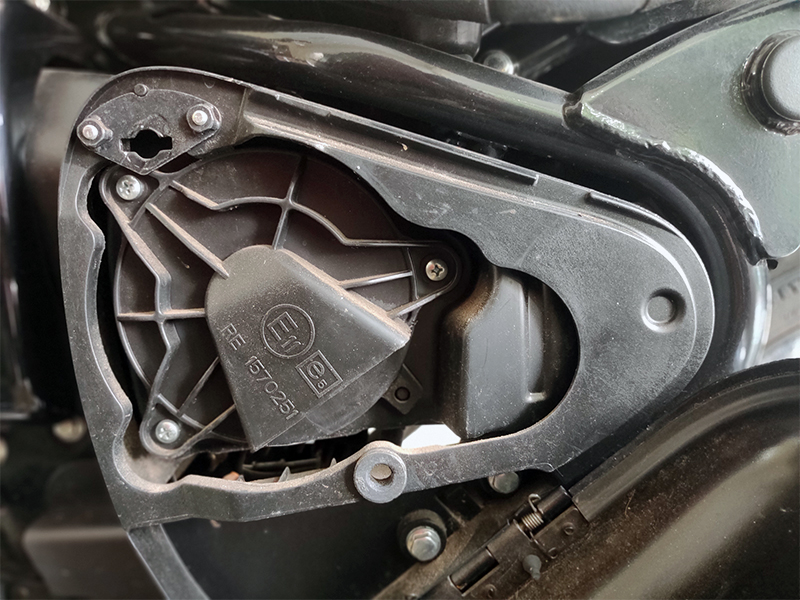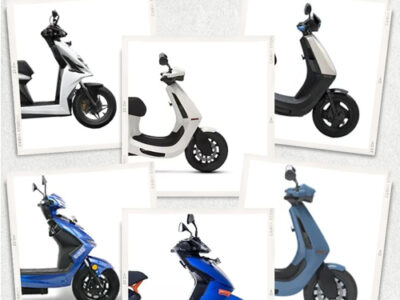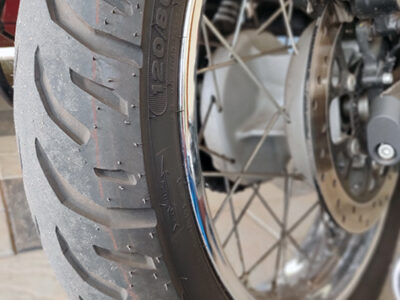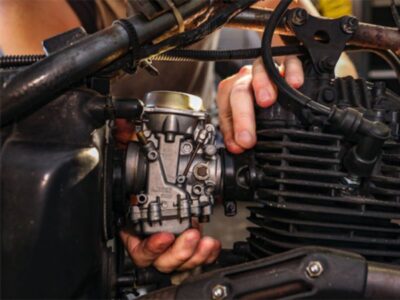
|
Getting your Trinity Audio player ready...
|
Long story short: Bike service at home doesn’t have to be complicated. You can ensure your bike stays in excellent condition with the right approach and some essential tools. This guide offers expert advice on performing regular maintenance tasks at home, such as checking bike tyre pressure and cleaning the chain.
Have you ever wondered why the owner manual contains a section for minor maintenance tips? There are several benefits for both the manufacturer and the consumer. Do you need to know why?
Taking care of your motorcycle is essential for keeping it running smoothly and safely for years to come. Regular maintenance is even more critical in India, where various weather and road conditions exist.
This article will walk you through some accessible and critical bike maintenance tips that you can do at home with the help of the owner’s manual specifically designed for riders like you in India. Let’s keep your bike in great shape!
Why home bike maintenance matters
The Indian motorcycle market is experiencing significant shifts, with a growing focus on entry-level bikes that cater to new riders. Despite a general decline in sales for some brands globally, the market for small displacement bikes is gaining traction.
Performing basic maintenance/service tasks at home saves money and deepens your understanding of your bike. This knowledge can prevent minor issues such as loose bolts, worn brake pads, low tyre pressure, etc., ultimately extending the life of your bike and ensuring a safer riding experience.
It’s not just about maintaining your motorcycle; it’s about taking control of its upkeep and feeling capable. DIY maintenance can give you a sense of power and a deeper connection with your machine. But remember, it’s essential to strictly adhere to the owner’s manual instructions, take only calculated risks, and never be overconfident.
The importance of regular bike maintenance
Regular maintenance is not just about keeping your motorcycle running; it’s about ensuring your safety on the road. Consistent checks on essential components such as brakes, tyres, lights, and steering can intercept potential issues before they become serious problems, providing you with a secure and protected riding experience.
Neglecting these checks could lead to accidents or costly repairs, underlining the importance of regular maintenance for your safety and the longevity of your bike. This proactive approach to maintenance can catch potential issues early, preventing them from escalating into more severe problems.
Benefits of having minor bike maintenance tips in the owner manual
1. Cultural Factors
In India, biking is often associated with personal rejuvenation and a sense of freedom rather than just being a means of transportation. This cultural perception encourages individuals to take a personal interest in maintaining and caring for their motorcycles.
Community and Knowledge Sharing
Biking in India has a vital community aspect, where riders often share tips and advice on maintenance and repairs. This communal knowledge-sharing culture influences manufacturers to include DIY tips in manuals to cater to this audience.
Self-Reliance and Skill Development
The Indian culture has a strong tradition of self-reliance, which extends to vehicle maintenance. Including DIY maintenance tips in manuals caters to this cultural preference for understanding and maintaining one’s vehicle.
2. Economic Factors
Cost Sensitivity and Savings
The Indian market is highly price-sensitive, and consumers often look for ways to reduce costs associated with vehicle maintenance. Providing DIY maintenance tips in manuals empowers consumers to perform basic maintenance tasks, thus saving service costs.
Limited Access to Professional Services
Access to professional bike servicing centres may be limited in many parts of India, mainly rural areas. This limitation makes it practical and necessary for bike owners to perform essential maintenance themselves.
Market Competition and Value Addition
The competitive nature of the Indian automotive market drives manufacturers to look for ways to add value to their products. Including DIY maintenance tips can be an added value that enhances customer satisfaction and loyalty.
3. Industry-Specific Factors
Manufacturer Benefits
Including DIY maintenance tips in manuals offers several benefits to manufacturers:
Cost Reduction and Efficiency
By empowering consumers to handle minor issues themselves, manufacturers can reduce the frequency of service visits, leading to decreased operational costs associated with after-sales service and warranty claims.
Customer Satisfaction and Loyalty
Offering DIY tips enhances customer satisfaction by providing knowledge and tools for independent maintenance, potentially increasing brand loyalty.
Market Differentiation
Comprehensive DIY maintenance tips are a differentiator in a competitive market, positioning the brand as customer-centric and innovative.
Enhanced Product Perception
Including DIY tips can improve product value, as consumers may view the motorcycle as more user-friendly and cost-effective.
Consumer Benefits
The inclusion of DIY maintenance tips also provides significant benefits to consumers:
You can save money by reducing the need for professional services for minor repairs and maintenance tasks by performing DIY Maintenance. This financial savvy and responsibility can be a significant benefit of DIY maintenance.
Convenience and Independence
Owners gain the convenience of performing maintenance at their own pace and location without the need to schedule and visit service centres.
Increased Engagement
DIY tips can increase consumer engagement with the product, potentially leading to a stronger connection to the brand and enhanced overall satisfaction.
Essential tools for home bike maintenance/service
Before diving into bike maintenance/service tasks, having the right tools at your home is crucial. Here’s a List of essential tools you’ll need at home for basic bike maintenance/service :
- A comprehensive toolkit (often provided with the motorcycle)
- Wrench set (including a torque wrench)
- Screwdriver set
- Pliers
- Allen key set
- Oil filter wrench
- Funnel
- Rags or microfiber cloth
- Lubricating oil and grease
- Tyre pressure gauge
- Battery tester
- Multimeter (for electrical issues)
Investing in quality tools ensures better performance and enhances your confidence in handling your motorcycle’s upkeep.
List of home bike maintenance/service tasks
Proper engine oil level protects engine components from faster wear and tear. Here’s how to perform an oil level check:
1. Engine oil level checking
- Ensure the bike is in the centre stand.
- Switch on the engine and gently raise the RPM (Half throttle) for 10 seconds.
- Leave the bike in idling condition for 15 seconds.
- Switch OFF the engine & wait for the oil to settle down (Approximately 1 to 2 minutes).
- The engine oil level should be at the maximum level.
- If the oil level is not in the abovementioned condition, top up the oil to the “MAX” condition and repeat the procedure.
- Do not overfill, which may affect the clutch function.
2. Engine oil changes
Regular oil changes are crucial for keeping your engine running smoothly and prolonging its life. Here’s how to perform an oil change:
- Warm up the engine for a few minutes to ensure the oil drains easily.
- Place a drain pan under the oil drain plug.
- Remove the oil filler cap and drain plug, allowing the oil to drain completely.
- Replace the drain plug with a new washer if necessary.
- Fill the engine with the recommended amount and type of oil.
- Replace the oil filler cap and run the engine for a minute.
- Check for leaks and ensure the oil level is correct using the dipstick.
- Dispose of the used oil properly at a recycling centre.
In India’s hot climate, it is advisable to change your oil more frequently, typically every 3,000 to 5,000 kilometres, depending on your riding conditions and oil type.
3. Chain Maintenance
Proper chain maintenance is essential for smooth power transmission and preventing premature wear. Follow these steps:
- Clean the chain regularly with a specialized chain cleaner.
- Use a brush to remove dirt and grime from the chain links.
- After cleaning, allow the chain to dry completely.
- Apply a high-quality chain lubricant specifically designed for motorcycles.
- Adjust the chain tension according to your motorcycle’s specifications.
- Inspect the chain for wear and replace it when necessary.
In India’s diverse climate, it’s recommended that you clean and lubricate your chain every 500 to 1,000 kilometres or more frequently if riding in wet or dusty conditions.
4. Tyre Maintenance
Proper tyre maintenance is crucial for safety and optimal performance.
Here’s what you need to do:
- Check tyre pressure when the tyres are cold (before riding).
- Inspect tyres for any signs of wear, cuts, or embedded objects.
- Adjust pressure according to load and riding conditions.
- Use a reliable tyre pressure gauge for accurate measurements.
Given India’s varied road conditions, checking your tyre pressure more frequently is essential, especially before long rides or when carrying an extra load.
5. Brake Inspection
Regular brake maintenance is vital for your safety. Perform these checks:
- The front and rear brake pads must be checked for wear at the intervals specified in the periodic maintenance chart.
- The pads must be replaced if a brake pad is worn to the indicator.
- Check brake fluid levels and top up if necessary.
- Look for any signs of brake fluid leaks.
Brake pads should be inspected every 1,000 kilometres, and depending on usage and riding conditions, they may need replacement every 10,000 to 15,000 kilometres.
6. Air Filter Maintenance
A clean air filter ensures optimal engine performance. Here’s what to do:
- Locate and remove the air filter.
- Pull out the filter element and check for dirt. Clean filter element carefully.
- Clean carefully for dust and oil particles inside the air filter box.
- High-pressure compressed air is not recommended for cleaning air filter elements.
In India’s often dusty conditions, it’s advisable to check your air filter every 5,000 kilometres and replace it if needed.
7. Battery Maintenance
Proper battery care prevents starting issues. Follow these steps:
- Check battery terminals for corrosion.
- Clean the wire terminals free from corrosion and keep the terminals coated with petroleum jelly.
- When removing the battery connections, always disconnect the black negative (-ve) battery cable first and then the red positive (+ve) cable.
- Always connect the red (+ve) positive terminal only after connecting the black (-ve) negative terminal.
- Keep the red (+ve) positive and (-ve) negative terminal cables connected to the respective battery terminals. Failure to do so may damage the motorcycle’s electrical system.
- Ensure the battery is charged correctly.
- Replace the battery if it shows weakness or is over 3-4 years old.
In India’s hot climate, checking battery fluid levels more frequently is crucial. The poor contact or loose fitment of battery terminals may cause electrical/electronic parts failure.
8. Spark Plug Maintenance
A bad spark plug can lead to engine misfiring and various other issues. So follow these steps to avoid this irking issues:
- Disconnect the spark plug caps from the spark plugs.
- Locate the spark plug spanner on the spark plug, loosen it, and remove it from the cylinder head.
- Check the spark plug for carbon deposits and centre electrodes for uneven wear.
- Clean the insulator tip and electrodes of the plug carefully.
- Check and set the electrode gap per the owner’s manual.
- Always replace spark plugs only as per recommended specifications.
- Refit the spark plug on the cylinder head as per tightening torque specification & refit the spark plug cap on the spark plug.
9. Clutch cable free play inspection/ adjustment
The clutch cable’s free play plays a significant role in clutch life, and it is recommended that you adjust it whenever necessary for good clutch life.
- Free play should be measured at the clutch lever’s ball end per the owner’s manual.
- The clutch lever is to be actuated 3 times before any measurement.
- Locate the clutch cable adjuster near the clutch lever on the handlebar.
- Check the free play in the clutch lever (usually 2-3 mm).
- If adjustment is needed, loosen the locknut on the adjuster.
- Turn the adjuster to increase or decrease cable tension.
- Tighten the locknut once the correct free play is achieved.
- If the handlebar adjuster doesn’t adjust enough, locate the secondary adjuster near the engine.
- Repeat the process with the secondary adjuster if necessary.
- Test the clutch operation to ensure smooth engagement and disengagement.
Maintenance considerations specific to India
When maintaining your motorcycle in India, keep these factors in mind:
- Climate: India’s diverse climate requires frequent maintenance checks, from scorching summers to monsoon rains. Pay extra attention to cooling systems and perform more frequent oil changes in hot weather.
- Road Conditions: Variable road quality in India necessitates regular checks of suspension systems and tyres. Be prepared for unexpected wear and tear due to rough roads.
- Availability: In some regions, obtaining genuine spare parts can be challenging. Stock up on essential parts and quality oil when available, especially if you live in remote areas or plan long rides.
Safety Precautions and Best Practices
When performing bike maintenance/service at home, always prioritize safety:
1. Maintain a Safe Work Environment
- Ensure your workspace is well-lit and ventilated to prevent accidents and exposure to harmful fumes.
- Do not perform maintenance work under direct sunlight.
- Keep your work area clean and organized to locate tools and parts quickly.
- Have a first aid kit readily available to handle minor injuries that might occur during maintenance.
2. Use the Right Tools for the Job
- Equip yourself with essential tools such as socket wrench sets, wrenches, screwdrivers, spanners, hex bit sockets/Allen wrenches, impact wrench/driver, hammer, pressure gauge, pliers, torque wrench, oil filter wrench, chain breaker and rivet tool, and a multimeter.
- Ensure all tools are in good condition and adequately maintained to prevent accidents or damage to your motorcycle.
- Use specialized tools like chain breakers and tyre irons for specific maintenance tasks.
3. Follow Safe Tool Usage Practices
- Ensure sockets are correctly seated on bolts to avoid slipping and potential injury.
- Use the correct size wrench to prevent rounding off bolt heads.
- Apply the correct amount of pressure when using screwdrivers to avoid stripping screw heads.
- Use gentle taps when using a hammer to avoid damaging parts.
- Regularly calibrate your torque wrench to maintain accuracy.
4. Refer to the Owner’s Manual
Always consult your bike owner’s manual before starting home maintenance/service tasks. It provides specific instructions on maintenance procedures, including the location of components and correct bike torque settings for bolts and nuts.
When to Seek Professional Help
While many bike maintenance/service tasks can be performed at home, some situations require professional assistance:
- Complex mechanical issues like engine malfunctions or transmission problems.
- Major suspension repairs.
- Complete brake system overhauls.
- Significant electrical troubleshooting.
- When you lack the necessary tools or expertise for a specific task.
Regular professional check-ups, at least once or twice a year, can help identify issues that may not be apparent during home bike maintenance/service.
FAQs on how to perform essential bike maintenance/service at home in India
1. How should I prepare my motorcycle for the monsoon season in India?
For more details, check out our dedicated article for the same Monsoon bike ride – Ultimate guide for India/
2. How do I choose the right engine oil for my motorcycle in India’s climate?
For more details, check out our dedicated article for the same Bike engine oil – Everything you need to know explained
3. What are the signs that my motorcycle’s air filter needs cleaning or replacement in India?
Signs that your motorcycle’s air filter needs cleaning or replacement in India include:
- Reduced fuel efficiency
- Loss of engine power
- Black smoke from the exhaust
- Difficulty starting the engine
- Unusual engine sounds
- Visible dirt or debris on the air filter
- The filter has been in use for more than 12,000-15,000 kilometres
In India’s dusty conditions, it’s advisable to check and clean the air filter every 3,000-5,000 kilometres and replace it every 12,000-15,000 kilometres or as the manufacturer recommends.
4. How can I prevent rust on my motorcycle during India’s humid climate?
To prevent rust on your motorcycle in India’s humid climate:
- Wash your bike regularly and dry it thoroughly.
- Apply a protective wax coating to the painted surfaces.
- Use a rust-inhibiting spray on exposed metal parts.
- Keep the motorcycle covered when not in use.
- Store the bike in a dry, well-ventilated area.
- Address any paint chips or scratches promptly to prevent rust from forming.
- Apply a thin layer of oil on chrome parts to protect them from moisture.
- Use silica gel packets to absorb excess moisture in storage areas.
- Regularly inspect and clean areas prone to water accumulation.
- Consider using a dehumidifier in your storage area during extremely humid seasons.
5. What are the signs that my motorcycle’s spark plugs need replacement?
Signs that your motorcycle’s spark plugs need replacement include:
- Difficulty starting the engine
- Rough idling or misfiring
- Decreased fuel efficiency
- Loss of engine power
- Acceleration issues
- Engine surging or hesitating
- Visible wear or damage on the spark plug electrodes
It’s generally recommended that spark plugs be replaced every 10,000 to 15,000 kilometres or as specified in your motorcycle’s manual.
Here are some related articles from our team
- Bike engine oil – Everything you need to know explained
- Motorcycle chain – how to clean, adjust & maintain
- Second hand motorcycle:Things to know when buying It
- Electric scooter maintenance – Top tips for longevity
- Motorcycle fuel tank – How to maintain properly
Conclusion
Regular home maintenance/service of your bike is not just about saving money; it’s about ensuring your safety, extending your motorcycle’s life, and enhancing your riding experience. By following this comprehensive guide and considering the specific conditions in India, you can keep your bike in top shape, ready for whatever adventures lie ahead on India’s diverse roads.
Remember, while home maintenance and service are valuable, it’s equally important to recognize when professional bike repair help is needed. With the right balance of home care and professional service, your motorcycle will continue providing reliable, enjoyable rides for years.
By taking care of your motorcycle, you’re not just maintaining a vehicle but preserving a symbol of freedom and independence deeply ingrained in India’s young, dynamic culture. Stay safe, ride responsibly, and enjoy the journey of maintaining your motorcycle at home in India!
If you have any questions or need more information, email us at bikeleague2017@gmail.com or leave a comment below. We’re always here and happy to help!. Similarly, don’t forget to check out Bikeleague India on our social media platforms to stay connected!.

















